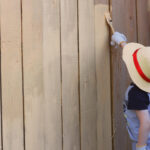Installing a fence can serve multiple purposes, including defining boundaries, enhancing privacy, and adding aesthetic appeal to your property. However, it’s crucial to understand property rights and legal considerations when it comes to fence placement. One common question that arises is whether it is permissible to put a fence on your neighbor’s side of the property line. In this blog, we will explore the topic and provide insights into the legality and implications of installing a fence on your neighbor’s side of the property line.
Respecting Property Rights
Respecting property rights is a fundamental aspect of being a responsible property owner. The property line is a legally defined boundary that separates one property from another. Encroaching on your neighbor’s side of the property line without permission can lead to disputes, legal complications, and strained relationships.
Permission and Agreements
In general, you should not build a fence on your neighbor’s side of the property line without obtaining their explicit permission. Open and honest communication with your neighbor is essential before undertaking any construction that could potentially affect their property. If you wish to build a fence that extends beyond your property line, it is advisable to discuss the matter with your neighbor and formalize a written agreement, outlining the specifics of the fence installation and any shared responsibilities.
Boundary Agreements and Easements
In some cases, neighbors may establish boundary agreements or easements that allow for shared use or construction of structures near the property line. These agreements define the rights and responsibilities of each party and often require legal documentation. If you and your neighbor are considering building a fence that straddles the property line, consult legal professionals to ensure that all necessary agreements and permits are in place.
Encroachments and Legal Consequences
Building a fence without permission on your neighbor’s side of the property line can be considered an encroachment, which is an unauthorized intrusion onto another person’s property. Encroachments can result in legal disputes, potential court action, and even removal of the encroaching structure. It is important to respect your neighbor’s property rights and seek appropriate permissions and agreements to avoid such conflicts.
Property Surveys and Professional Advice
To accurately determine the location of the property line and avoid any boundary disputes, consider hiring a professional land surveyor. A surveyor can conduct a survey to establish precise property boundaries and provide documentation that can guide fence placement. Additionally, consult with legal professionals to ensure compliance with local laws, regulations, and any specific requirements pertaining to fence installation.
Placing a fence on your neighbor’s side of the property line without permission is generally not permissible and can lead to legal complications and strained relationships. Respecting property rights, open communication, and obtaining written agreements or easements are essential when considering fence placement. Consulting professionals, such as surveyors and legal advisors, can provide valuable guidance to ensure compliance with property laws and maintain a harmonious neighborhood environment. Remember, it is always better to approach fence construction with a respectful and cooperative attitude towards your neighbors.







